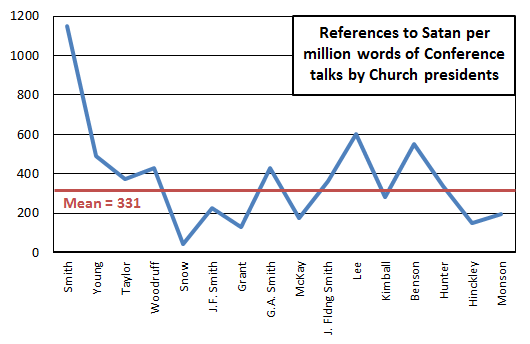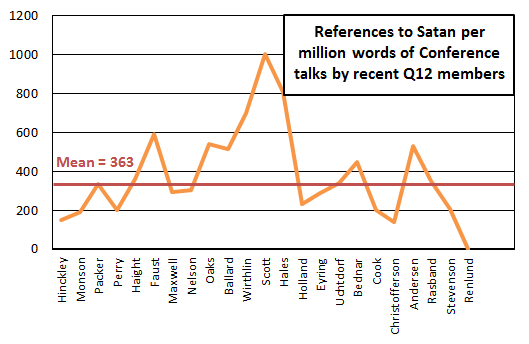In Lynnette’s post a couple of days ago on turning to Christ in the midst of sin, she wrote about how she identified with the struggle to feel worthy to turn to Christ that Martin Luther expressed hundreds of years ago, although, she noted, Luther was more likely to attribute the difficulty of the struggle to the whisperings of Satan, while she as a product of the twentieth century leans more on the language of mental illness. This is a major tangent, but this contrast got me to wondering which GAs today are more or less likely to attribute things to Satan.
Figuring out who’s attributing stuff to Satan is a more difficult task than I really wanted to take on, so I settled for just looking up which GAs talk about Satan the most. Fortunately for me, the LDS General Conference corpus has recently been updated to make it much easier to get results split out by speaker. This even allowed me to broaden my search a little, to include other Conference speakers such as general church officers. I searched the corpus by speaker for uses of “Satan,” as well as three fairly synonymous terms: “devil,” “Lucifer,” and “adversary.” Then I just added up the frequency for each speaker, and converted the results into uses per million words to make them easier to look at. (If you’re interested in differences between how often these terms are used here’s a post I wrote several years ago on that question.)
So who do you think holds the title for referring to Satan most frequently in Conference talks?
You’ll never guess.
Really, you won’t.
It’s Michaelene P. Grassli, who was General Primary President from 1988 to 1994. She referred to Satan 4,459 times per million words in her Conference talks. I know, I know. You’re thinking that she only gave one or two Conference talks, so this is too small a sample to be meaningful. And you’d be partly right. She didn’t give a large number of Conference talks. But it wasn’t one or two. She actually gave five. Of those five, two are really the source of her big numbers: “Follow Him” and “Helping Children Know Truth from Error.”
President Grassli had about 9,200 total words in her talks. What if we set the threshold to about twice that, say 20,000 words? Then who is the champion? It’s Bernard P. Brockbank, who was an Assistant to the Quorum of the Twelve and later a Seventy in the 1960’s and 70’s. He referred to Satan 2,211 times per million words.
If we want to go more recent, say someone who has been a GA since the beginning of Gordon B. Hinckley’s presidency, then the champion is Richard C. Edgley, longtime member of the Presiding Bishopric. He referred to Satan 1,617 times per million words.
If we limit ourselves to speakers who were in the Q15, then Joseph F. Merrill is the champ. He referred to Satan 1,393 times per million words.
Finally, combining the recency criterion and the Q15 criterion, Richard G. Scott is the winner, with 1,004 references per million words.
Here are the top 20 overall:
| Speaker | Words | Satan refs | Refs/million |
|---|---|---|---|
| Michaelene P. Grassli | 9,195 | 41 | 4,459 |
| Ulisses Soares | 4,194 | 13 | 3,100 |
| John Young | 11,836 | 30 | 2,535 |
| Bernard P. Brockbank | 42,055 | 93 | 2,211 |
| Francis M. Gibbons | 5,218 | 11 | 2,108 |
| Richard C. Edgley | 21,647 | 35 | 1,617 |
| Tad R. Callister | 6,857 | 10 | 1,458 |
| Sheri L. Dew | 13,236 | 19 | 1,435 |
| W. Craig Zwick | 4,931 | 7 | 1,420 |
| Joseph F. Merrill | 86,872 | 121 | 1,393 |
| Eldred G. Smith | 77,631 | 106 | 1,365 |
| Linda S. Reeves | 4,403 | 6 | 1,363 |
| William R. Bradford | 14,718 | 18 | 1,223 |
| Spencer J. Condie | 6,741 | 8 | 1,187 |
| Gene R. Cook | 14,649 | 17 | 1,160 |
| Joseph Smith | 13,052 | 15 | 1,149 |
| W. Eugene Hansen | 6,301 | 7 | 1,111 |
| Jedediah M. Grant | 56,452 | 62 | 1,098 |
| L. Lionel Kendrick | 4,591 | 5 | 1,089 |
| George P. Lee | 10,413 | 11 | 1,056 |
Elder Scott is #21, with 111,509 total words, 112 references to Satan, and a rate of 1,004 references per million words.
You probably noticed Joseph Smith at #16, with a surprisingly small total number of words. This brings up the point that the General Conference corpus has incomplete data, particularly for older Conferences. So you should take Joseph Smith’s numbers–and really all older numbers–with a large grain of salt.
One other thing I noticed is that there are three women in the top 20. This might not sound like much, but considering how few women have given talks across the whole history of General Conference, it seems like a lot. I wondered if women were more likely to refer to Satan in Conference than men are. I classified each speaker into one of four categories: Church president, Q12, other men, and women. For the men, I categorized them based on their highest office achieved rather than their office at the moment. Here is the average rate of Satan references for each of the four groups:
Women: 491
Q12: 346
Other men: 346
Presidents: 331
It seems like maybe the women are different from the other groups, although I’m not sure whether it’s worth doing a statistical significance test of the difference. When I removed President Grassli from the women, their rate fell to 384, which suggests that the difference might not be meaningful if it’s attributable to one person with two talks.
I also thought it might be interesting to look at rates for Church Presidents only. Here they are, but again keep in mind that the data aren’t complete particularly for the 19th century.
 The rates for Presidents Benson, Hinckley, and Monson are all in accord with my expectations. For President Benson, I wonder if his referring to Satan a lot isn’t connected to his referring to communists a lot, kind of like he was into conspiracy theories both natural and supernatural to explain stuff that he didn’t like in the world. Then Presidents Hinckley and Monson both seem less likely to talk about Satan a lot, and the numbers bear this out.
The rates for Presidents Benson, Hinckley, and Monson are all in accord with my expectations. For President Benson, I wonder if his referring to Satan a lot isn’t connected to his referring to communists a lot, kind of like he was into conspiracy theories both natural and supernatural to explain stuff that he didn’t like in the world. Then Presidents Hinckley and Monson both seem less likely to talk about Satan a lot, and the numbers bear this out.
One other group I thought it might be fun to look at is the recent Q15 members. I used the same cutoff for recency that I did before: anyone who was in the Quorum since the beginning of President Hinckley’s tenure counts as recent. Here are the results:
 You can see Elder Scott is an outlier at the high end, and at the low end are Elders Christofferson and Renlund. Elder Renlund is an interesting case. I couldn’t get the General Conference corpus to give me anything on him, so I manually checked all of his talks, and as far as I can tell, his next reference to Satan in Conference will be his first.
You can see Elder Scott is an outlier at the high end, and at the low end are Elders Christofferson and Renlund. Elder Renlund is an interesting case. I couldn’t get the General Conference corpus to give me anything on him, so I manually checked all of his talks, and as far as I can tell, his next reference to Satan in Conference will be his first.
One final point is that all of these rates seem pretty low. Even Elder Scott, for example, at about 1,000 references per million words, that’s one word in 1,000. It’s not that he was talking about Satan constantly; it’s just that he was talking about Satan more than his fellow GAs were.
In the chart for the church presidents only, does the data include their entire speaking career or only the years they were prophet? I know that sometimes there is a stark change in habits when speaking as an apostle as contrasted to speaking as a prophet. That would be interesting to see if there is a break between the two.
I think they are all playing catch up to the church lady!
https://en.wikipedia.org/wiki/The_Church_Lady
🙂
(and if you want to know why I posted this, the devil made me do it!)
Good question, Starfoxy. It’s their entire speaking career. I’m not sure of a way to limit by current office held, although I’m still playing around with the new General Conference corpus interface.
Ha, Happy Hubby! That’s perfect! I’m sure you’re right. The GAs are waaaay behind!
Well isn’t that special! 🙂
Really interesting, Ziff. You raise more questions than can be answered by numbers, but raising the questions matters, so thank you.
I’ll have to look up the talks you analyzed in order to answer my own question: Is there a difference in HOW various speakers have refered to Satan? I don’t have a particular response as a listener when a speaker makes a passing reference to “the adversary” or cites the devil as the generic source of generic temptation. But I was seriously creeped out even by reading — I suspect I could hardly have borne to hear it aloud — Elder Lawrence’s talk/article in last month’s Ensign, and my response was entirely apart from any particular counterfeits he condemned. My creeped-out-gut-response was to the way he went into detail about Satan’s motives and methods, getting inside his (Satan’s) head in a way that means he had to have, even temporarily, put himself in Satan’s shoes and seen things through Satan’s eyes, and he seemed actually to have enjoyed that. It was like porn, or like particularly successful horror stories, the way he almost lovingly examined those ideas, returning to them, rolling the words around on his tongue and savoring this intimate knowledge of Satan. Assuming for the sake of argument that everything he said was true, I learned far more about Satan in that article than I usually do about Jesus Christ in other featured articles.
I know that isn’t something that you could address with word counts, but it brings back to mind my visceral response to that article. I think I would have noticed Conference talks that came within even a mile of the same personal contemplation of evil in that article — it makes me want to take a closer look at HOW these speakers did refer to it.
As always, I love your numbers posts! I find it interesting that Wirthlin, Scott, and Hales, all called right around the same time, have an elevated Satan score. What does this say about the First Presidency at that time (Benson, Hinckley, and Monson) who made these calls? What does that say about the late 80’s when these men were all called?
The one concern I have with this approach is one talk could skew a GA’s Satan score. For example, Faust’s “The Great Imitator” was explicitly about Satan. Thus, this talk alone likely contributed a large number of devil references to his overall score. Another interesting metric may be “talks with Satan references / total talks the GA gave”. (I imagine the results would be similar, but may hold a few surprises.)
Thanks, Ardis. I agree, that that type of analysis would be far more interesting. Your point about Elder Lawrence’s talk reminds me of something I think I remember reading in an afterword to The Screwtape Letters. C.S. Lewis said something about writing a sequel or doing more similar work, but that it was disturbing to him how easily he could slip into Screwtape mode, and so he didn’t want to do it. It sounds like your impression of Elder Lawrence is that he also slipped into that view easily, but that perhaps he was enjoying it in a disturbing way.
Thanks, MTodd. That’s a good question about the climate in which these Q15 members were called maybe influencing their outlook, or perhaps the climate affecting what type of men were called. And I agree that the variation on the analysis you propose would be interesting to uncover cases where a speaker just talks about Satan a lot in one talk versus sprinkling references across many talks. That’s probably more doable for a numbers person like me, so maybe I’ll see if I can do it with this or a future analysis.
My impression, Ardis, wasn’t that he enjoyed it so much as that he had been there. His was the voice of experience. If you were creeped out, it might be because once you understand where those dark whispers are coming from, it’s creepy.
As an adult convert myself, under circumstances similar to those of Elder Lawrence (I even got started with A Marvelous Work and a Wonder and married the woman who got me on the path), it was easy to relate to what he was saying, easy to remember how those whispers have an effect on me, easy to envision how very, very difficult it has been – and in some ways continues to be – to resist that voice. Simply put, I got used to it in my formative years. It takes a lot of work to rewire oneself.